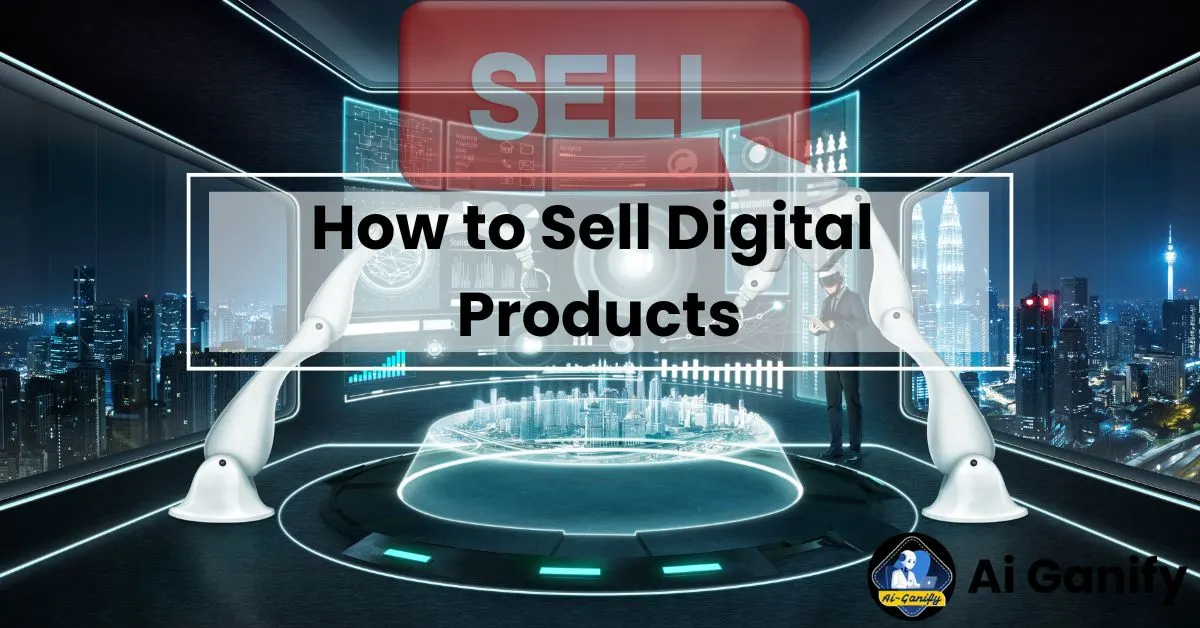
Introduction: The Future of Selling is Digital
The Rise of Digital Products
We live in a digital-first world, where everything from books to music to design templates can be bought with just a few clicks. In this article you will learn how to sell digital products.
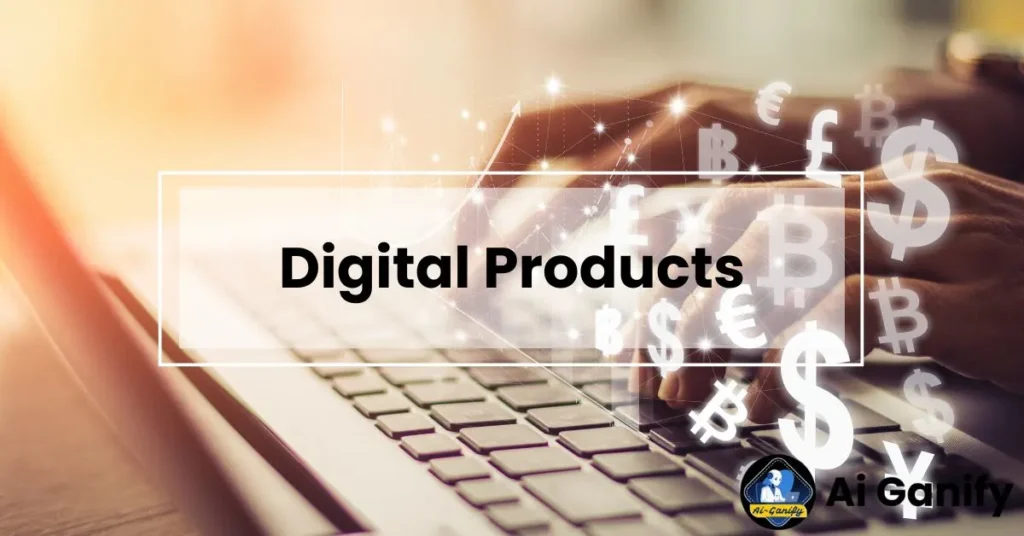
Years ago, selling products meant inventory, shipping, and handling customer returns. But today? Anyone with an idea can create and sell digital products—no warehouses, no packaging, and no shipping costs.
This shift isn’t just a trend—it’s the future. Businesses and solo entrepreneurs are making millions selling digital goods like eBooks, courses, and printables. And the best part? Once created, digital products can be sold an unlimited number of times, making them one of the best sources of passive income.
Why Selling Digital Products is a Game-Changer
Unlike physical products, digital goods come with massive advantages that make them an attractive business model. Here’s why:
✅ Low Cost to Start – No need for expensive inventory, manufacturing, or shipping.
✅ High Scalability – Sell one product to thousands of people without additional production costs.
✅ Passive Income Potential – Create once, sell forever. Digital products keep generating revenue while you sleep.
✅ Unlimited Earning Potential – No limits on stock. A single digital product can be sold 10 or 10,000 times without extra effort.
Think about it: Netflix, Canva, and online course platforms all operate on a digital product model. These businesses generate millions without ever handling physical goods.
Now, you don’t need a huge company to get started. Even solo creators are making a full-time income by selling digital planners, templates, or online guides.
Can You Really Make Money Selling Digital Products?
Yes, and thousands of people are already doing it!
Here are some real-life examples of digital product sellers making money:
💡 An artist creates digital illustrations and sells them as printable wall art on Etsy.
💡 A fitness trainer sells workout guides and meal plans as PDFs.
💡 A writer sells self-published eBooks and journals on Amazon.
💡 A graphic designer sells Canva templates for businesses to use in their marketing.
These are just a few examples. The key is to find a profitable niche that matches your skills and audience demand.
Of course, success doesn’t happen overnight. But with the right strategy, marketing, and pricing, digital products can become a consistent income stream.
What to Expect from This Guide
Selling digital products is not just about creating something and hoping people will buy it. You need a step-by-step approach.
Here’s what this guide will cover:
🚀 How to choose the right digital product to sell.
🚀 Where to sell it (platforms like Etsy, Shopify, and Gumroad).
🚀 Pricing strategies to maximize profit.
🚀 The best marketing techniques to attract buyers.
🚀 How to protect your products from piracy and ensure long-term success.
By the end of this guide, you’ll have everything you need to launch your own digital product business and start earning online.
Ready? Let’s dive in. 🚀
👉 Also Read: How to Make Money From Freelancing With No Skills
Understanding Digital Products
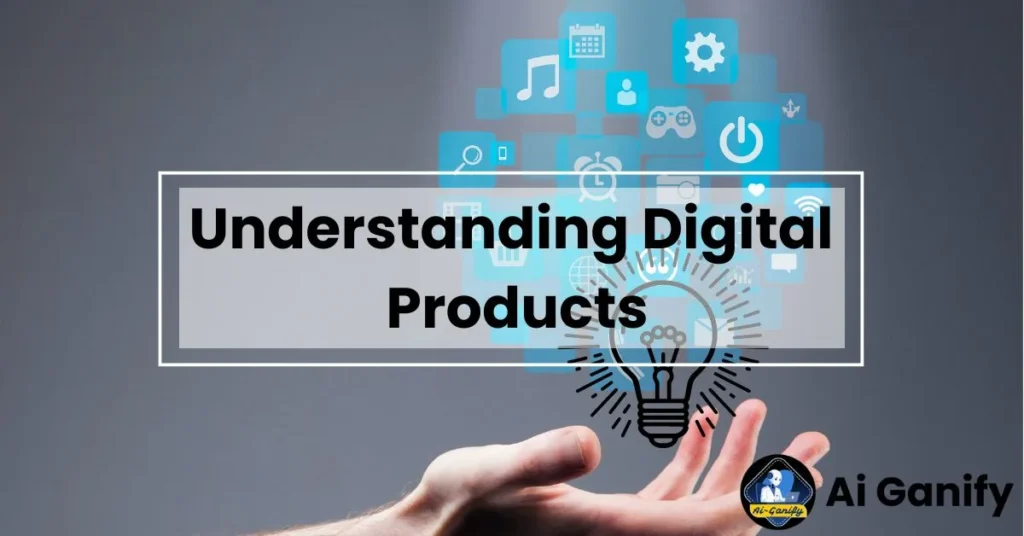
What Are Digital Products?
A digital product is any non-physical item that can be sold or distributed online. Unlike physical goods, digital products don’t require shipping, storage, or restocking.
Once created, they can be sold an unlimited number of times—making them one of the best ways to earn passive income.
Key Characteristics of Digital Products
✅ No Inventory – You don’t need a warehouse or stockpile.
✅ Instant Delivery – Customers receive their purchase immediately after payment.
✅ Low Overhead Costs – No manufacturing, shipping, or logistics involved.
✅ Scalability – Whether one person buys or a thousand, your cost remains the same.
✅ High-Profit Margins – With minimal production costs, most of the revenue goes directly into your pocket.
The best part? Anyone can create and sell digital products—even without technical skills.
Popular Types of Digital Products
There are endless digital product ideas, but some stand out because of high demand and profitability.
1️⃣ eBooks
Perfect for writers, bloggers, and educators. eBooks sell well in self-help, business, and education niches.
📌 Example: A freelancer writes an eBook on “How to Make Money on Upwork” and sells it for $19.99.
2️⃣ Online Courses
Video courses and tutorials are booming, especially in business, fitness, and personal development.
📌 Example: A fitness trainer creates a “30-Day Weight Loss Program” and sells it for $49.
3️⃣ Printables & Planners
People love downloadable journals, budget planners, and wedding organizers. They sell great on Etsy!
📌 Example: A teacher sells a “Homeschool Planner” to busy parents for $12.99.
4️⃣ Digital Art & Graphics
Artists and designers make money selling wall art, icons, and illustrations.
📌 Example: A graphic designer sells a bundle of social media templates for influencers.
5️⃣ Music & Sound Effects
Musicians and producers sell beats, background music, and sound effects for YouTubers and game developers.
📌 Example: A sound designer sells “100 Royalty-Free Sound Effects” for $25.
6️⃣ Software & Apps
Tech-savvy entrepreneurs create SaaS tools, WordPress plugins, and mobile apps.
📌 Example: A developer builds a simple invoicing tool for freelancers and charges a monthly fee.
Each of these products has a unique audience, price point, and selling strategy—which we’ll explore next.
How Different Digital Products Perform in Various Markets
Not all digital products sell the same way. Some work best in education, while others thrive in entertainment.
🔹 Education Market (High Trust, High Price)
People are willing to pay more for knowledge. Courses and eBooks do well here.
📌 Example: Online coding bootcamps charge over $1,000 per course.
🔹 Entertainment Market (High Demand, Lower Price)
People love graphics, music, and templates, but they expect them to be affordable.
📌 Example: A digital artist sells $5 Twitch overlays but sells hundreds of them every month.
🔹 Business Market (High Competition, High Value)
Freelancers and business owners buy tools that help them make money, such as SEO templates, sales funnels, and invoicing software.
📌 Example: A marketer sells a “Done-for-You Email Sequence” for $99.
The key is to match your product with a market that is willing to pay.
What Is the Best Digital Product to Sell?
The best digital product to sell depends on three key factors:
✅ Your Skills – What can you create easily? Writing, design, coding, or teaching?
✅ Market Demand – Are people searching for it? Use tools like Google Trends.
✅ Scalability – Can it be sold repeatedly with minimal updates?
Top 3 Profitable Digital Products (Based on Real Data)
📌 #1 Online Courses – People love learning new skills, and courses sell for high prices ($50–$500).
📌 #2 Digital Templates – Canva, PowerPoint, and Notion templates are hot-selling with high demand.
📌 #3 Subscription-Based Tools – A low-cost SaaS tool can generate recurring monthly income.
If you’re unsure what to sell, start with templates or printables—they’re easy to make and require no special skills.
Final Thoughts on Choosing a Digital Product
Selling digital products is one of the easiest ways to start an online business.
🔹 You don’t need inventory.
🔹 You don’t need shipping.
🔹 You only need a valuable product and the right audience.
Choosing the Right Digital Product to Sell
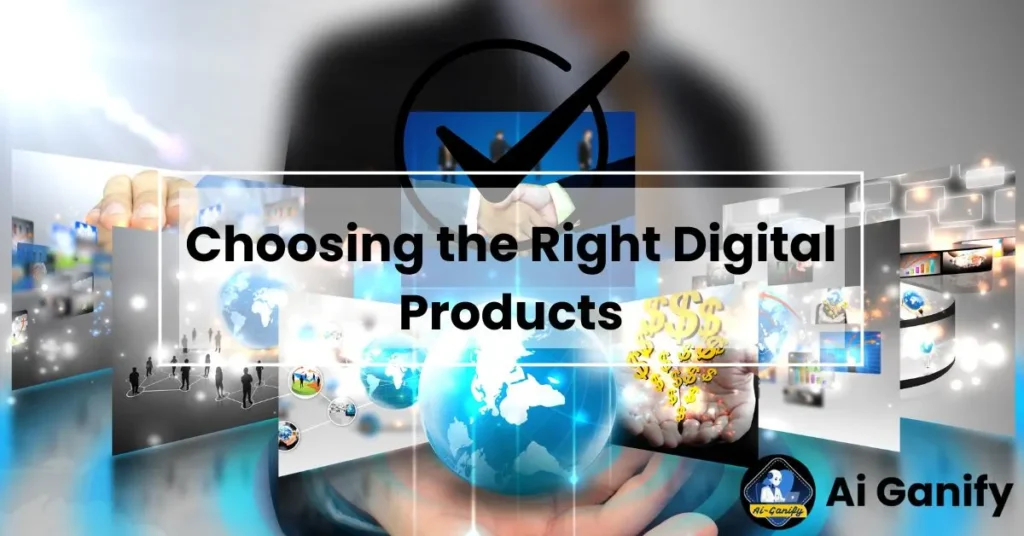
Creating a digital product is one thing. Making sure it actually sells? That’s where smart product selection comes in.
Choosing the right digital product can mean the difference between consistent sales and frustration.
Let’s break it down step by step so you can pick a highly profitable product with confidence.
How to Identify a Profitable Niche
The best digital product aligns with three factors:
✅ Demand – Are people actively searching for this product?
✅ Your Skills – Can you create this product efficiently?
✅ Market Trends – Is the demand increasing or declining?
Step 1: Find Market Demand
If nobody is searching for a product, it won’t sell.
Use these free tools to find high-demand digital products:
🔹 Google Trends – Check if the topic is trending upward.
🔹 Amazon Bestsellers – See what’s selling in the eBook and template categories.
🔹 Etsy & Creative Market – Look for best-selling printables, planners, and digital downloads.
📌 Example: A Google Trends search for “Notion Templates” shows a steady rise—meaning it’s a hot niche.
Step 2: Assess Your Skills
Even if a niche is profitable, you need to ask:
🔹 Can I create this product myself?
🔹 Will I need to hire someone?
🔹 How much time will it take?
📌 Example: If you’re great at design, creating Canva templates or printables is an easy way to start.
If you love teaching, an online course might be the better choice.
Step 3: Analyze Market Trends
Trends shift fast. What’s popular today may not sell next year.
🔹 Evergreen products – eBooks, productivity planners, and business templates sell year-round.
🔹 Trending products – AI-generated prompts, social media templates, and digital planners are currently hot.
📌 Example: AI-generated art prompts exploded in popularity in 2023. If you were early in this niche, you could have made thousands!
Researching Competition Using SEO & Online Marketplaces
You’ve found a niche—but how do you stand out in a crowded market?
Step 1: Check SEO Competition
Use free SEO tools to analyze competition:
🔹 Ubersuggest – Shows keyword difficulty and search volume.
🔹 Ahrefs (Free Keyword Generator) – Tells you how hard it is to rank for a keyword.
🔹 Google Autocomplete – Type your niche into Google and see suggested searches.
📌 Example: If “Etsy digital planners” has high competition, you might want to target “Minimalist Digital Planners for Notion” instead.
Step 2: Study the Best Sellers
Go to Amazon, Etsy, or Gumroad and look at the top-selling products in your niche.
Ask yourself:
✅ What are they doing right?
✅ What’s missing from their offer?
✅ Can I improve on their product?
📌 Example: If the top Etsy printable planner has 5,000 sales but customers complain about a lack of customization, you can create a fully editable planner to fill the gap.
Step 3: Spy on Your Competitors
Check their:
🔹 Pricing – Are they charging $10 or $100?
🔹 Marketing – Are they using social media, email lists, or paid ads?
🔹 Product Bundles – Are they offering multiple items instead of just one?
📌 Example: If the best-selling Notion templates are bundled, consider selling a 5-template pack instead of a single template.
Hidden Gold: Low-Competition, High-Profit Niches
Most people jump into oversaturated niches like eBooks or stock photos.
But there are less competitive markets that still make great money.
1️⃣ Digital Products for Local Businesses
Most real estate agents, salons, and fitness trainers need marketing templates but don’t know where to buy them.
📌 Example: “Real Estate Social Media Post Templates” for Instagram.
2️⃣ Niche-Specific Notion Templates
Instead of generic Notion templates, focus on a niche.
📌 Example: “Notion Templates for Music Producers” (beat tracking, lyric writing, music scheduling).
3️⃣ Digital Stickers & GIFs for Creators
Twitch streamers, YouTubers, and Instagram influencers buy unique digital stickers and GIFs for branding.
📌 Example: A pack of “Funny Twitch Emotes” for $10.
4️⃣ AI & Automation Tools for Businesses
Small businesses are desperate for automation tools to save time.
📌 Example: A simple AI-generated Instagram Caption Maker sold as a Notion template.
5️⃣ Guided Digital Experiences
Instead of a simple digital download, offer interactive or guided content.
📌 Example: A “30-Day Self-Improvement Challenge” with daily email prompts.
Final Thoughts on Choosing Your Digital Product
Choosing the right digital product isn’t about guessing—it’s about data, research, and differentiation.
✔ Find a niche with demand.
✔ Check the competition and identify gaps.
✔ Focus on low-competition, high-value products.
👉 Also Read: How to Make Money From Freelancing With No Skills
Creating High-Quality Digital Products

Once you’ve picked a profitable niche, it’s time to create a digital product that stands out.
Customers want well-designed, easy-to-use, and valuable products.
But here’s the mistake most beginners make: They focus too much on creating, but not enough on quality.
Let’s walk through how to make high-quality digital products effortlessly.
The Best Tools for Creating Digital Products
Not sure which tools to use? You don’t need expensive software to make great digital products.
Here are the best tools based on the type of product you’re creating.
🖼️ For Graphic-Based Products (Printables, Digital Art, Templates)
🔹 Canva – Perfect for eBooks, planners, templates, and social media graphics.
🔹 Affinity Designer – A budget-friendly alternative to Adobe Illustrator for digital art.
🔹 Procreate – Best for creating digital illustrations and stickers (iPad only).
📌 Example: A seller on Etsy makes $10,000/month selling editable Canva wedding invitation templates.
📖 For eBooks & Courses
🔹 Scrivener – Great for writing structured eBooks.
🔹 Google Docs – Free and easy for writing eBooks and guides.
🔹 Teachable / Thinkific – Platforms for hosting and selling online courses.
📌 Example: A 15-page eBook created in Google Docs and formatted in Canva can sell for $17 to $27.
🎵 For Music & Audio Products
🔹 Audacity – Free tool for recording and editing audio.
🔹 FL Studio – Popular for making beats and sound effects.
🔹 GarageBand – Simple and free for creating audio files on Mac.
📌 Example: A seller on Gumroad makes $5,000/month selling lo-fi background music for YouTubers.
💻 For Software & Website Templates
🔹 Figma – Best for UI/UX design and website templates.
🔹 Bubble.io – No-code tool for building apps.
🔹 Gumroad / CodeCanyon – Platforms to sell software scripts.
📌 Example: A simple Notion template can sell for $19 to $99, depending on the niche.
Step-by-Step Guide: Selling Digital Products Made on Canva
Canva is one of the easiest tools for creating and selling digital products.
Follow these simple steps to create and sell your first Canva-based digital product.
Step 1: Choose a Profitable Product
Think about what people actually need.
📌 Popular Canva-based products:
✔ Printable planners & workbooks
✔ Business card templates
✔ Instagram post & story templates
✔ Resume and cover letter templates
Step 2: Design Your Product in Canva
🔹 Use free elements (or get Canva Pro for premium ones).
🔹 Stick to a clean, professional design.
🔹 Ensure it’s fully editable for buyers.
📌 Example: A Pinterest pin template pack designed in Canva can sell for $10 to $30.
Step 3: Save & Upload in the Right Format
✅ PDFs – Best for printables & guides
✅ PNG/JPG – Best for graphics & social media templates
✅ Canva Share Link – Best for editable templates
Step 4: Sell on the Right Platforms
🔹 Etsy – Best for selling printables & templates
🔹 Gumroad – Great for guides & eBooks
🔹 Creative Market – Perfect for high-end templates & graphics
📌 Example: A seller on Etsy makes over $50,000/year selling editable Canva resume templates.
Step 5: Optimize Your Product Listing for Sales
🔹 Use keywords (e.g., “Minimalist Instagram Templates for Canva”).
🔹 Write a compelling product description that highlights benefits.
🔹 Include high-quality mockups.
Common Mistakes in Digital Product Creation (And How to Avoid Them!)
Many new creators rush into selling and make simple mistakes.
Here’s what to avoid (and how to fix it!).
❌ Mistake #1: Low-Quality Design
🚫 Blurry images, bad fonts, and cluttered layouts turn buyers away.
✅ Solution: Use professional fonts, clean spacing, and high-quality visuals.
📌 Example: A polished Canva social media template gets way more sales than a messy one.
❌ Mistake #2: No Demand for the Product
🚫 Many sellers create random products without checking if people actually want them.
✅ Solution: Research trends before creating! Use Etsy, Google Trends, and Amazon to find high-demand ideas.
❌ Mistake #3: No Clear Instructions for Buyers
🚫 Customers get confused if there’s no guide on how to use the product.
✅ Solution: Include a simple PDF guide or a quick video tutorial.
📌 Example: A digital planner seller added a “How to Use” guide and increased sales by 40%.
❌ Mistake #4: Pricing Too Low
🚫 Selling too cheap makes buyers think it’s low quality.
✅ Solution: Check competitors and price slightly above average if your product is high quality.
Final Thoughts: Creating a Digital Product That Sells
✔ Use the right tools to make high-quality products.
✔ Follow a proven process when selling Canva-based products.
✔ Avoid common mistakes to maximize sales.
Where to Sell Digital Products
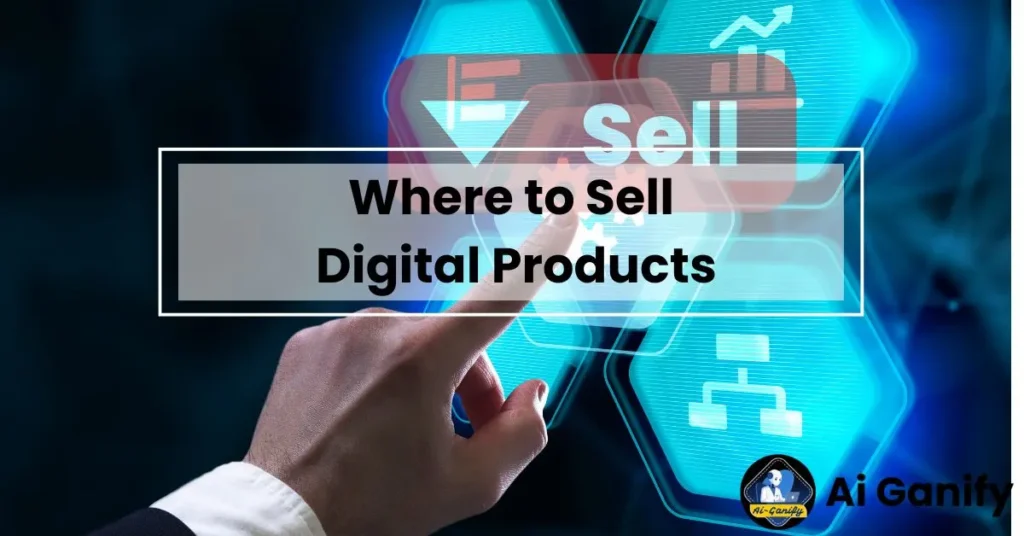
You’ve created your high-quality digital product—now what?
Choosing the right platform can make or break your success.
Some platforms give you more control, while others provide built-in traffic.
Let’s break down where to sell your digital products for maximum profit.
Best Platforms for Selling Digital Products
Not all platforms are created equal.
Here’s a side-by-side comparison of the most popular places to sell digital products.
🛍️ Shopify – Best for Building a Personal Brand
Pros:
✅ Full control over pricing, branding, and customer data.
✅ Can integrate with apps like Printful & SendOwl to automate sales.
✅ Scalable for long-term growth.
Cons:
🚫 Monthly fee ($39/month for Basic Plan).
🚫 You have to drive your own traffic.
📌 Example: A Shopify store selling Notion templates makes $15,000/month by driving traffic from Pinterest.
📦 Gumroad – Best for Beginner Creators
Pros:
✅ No monthly fee (only small transaction fees).
✅ Super easy to set up—perfect for selling eBooks, music, and templates.
✅ Allows subscriptions & pay-what-you-want pricing.
Cons:
🚫 Higher fees for free users (10% per sale).
🚫 No built-in marketplace, so you need to promote yourself.
📌 Example: A fitness coach sells meal plan PDFs on Gumroad, making $4,000/month with Instagram traffic.
🛒 Etsy – Best for Selling to an Existing Audience
Pros:
✅ Built-in traffic—millions of buyers search Etsy daily.
✅ Perfect for printables, planners, and digital templates.
✅ Low upfront cost (only $0.20 per listing).
Cons:
🚫 High competition—you need SEO-optimized listings.
🚫 Etsy takes a 6.5% transaction fee per sale.
📌 Example: A seller makes $10,000/month selling editable Canva templates for business owners.
💳 Payhip – Best for Zero Upfront Costs
Pros:
✅ No monthly fee (small per-sale commission).
✅ Automatic EU VAT handling (great for global sellers).
✅ Works for subscriptions & membership sales.
Cons:
🚫 Less popular than Gumroad, so you must drive traffic.
🚫 3-5% fee on free plans.
📌 Example: A blogger sells eBooks & Notion templates on Payhip, making $5,000/month from email marketing.
📚 Amazon KDP – Best for eBooks & Low-Cost Publishing
Pros:
✅ Access to millions of buyers—Amazon is the biggest eBook marketplace.
✅ No upfront cost—publish for free and earn royalties.
✅ Great for selling low-content books like planners & journals.
Cons:
🚫 Amazon takes a cut (30%-70% of royalties).
🚫 Strict content guidelines—your book must meet Amazon’s formatting standards.
📌 Example: A 20-page digital planner sold as a Kindle eBook earns $1,500/month in passive income.
Where Can I Sell Digital Products for Free?
Want to start selling without upfront costs?
Here are the best free platforms to sell digital products:
1️⃣ Gumroad
🚀 No monthly fee, but takes 10% per sale.
2️⃣ Payhip
🚀 No monthly fee, but charges 5% on free plans.
3️⃣ Ko-fi
🚀 Best for artists & creators—sell digital downloads with zero fees on paid plans.
4️⃣ Etsy (Technically Free)
🚀 $0.20 listing fee, but low risk to test products.
📌 Example: A new Etsy seller launched a digital budgeting planner with only $1.00 in upfront fees and made $500 in the first month.
Platform-Specific Success Strategies
Not all platforms work the same way.
Here’s how to maximize sales on different marketplaces.
🚀 How to Get More Sales on Etsy
✔ Use SEO-friendly product titles (e.g., “Minimalist Business Card Template | Editable Canva Design”).
✔ Offer bundle discounts—customers love deals!
✔ Upload high-quality mockups to showcase your product.
📌 Example: A seller boosted sales 300% by adding better mockup images to their Etsy listings.
🚀 How to Succeed on Gumroad
✔ Use Twitter & TikTok to drive traffic (Gumroad has no built-in audience).
✔ Offer “Pay What You Want” pricing—people often pay more than expected!
✔ Use Gumroad’s email tools to sell more to past buyers.
📌 Example: A digital artist made $20,000 in a month by offering “Pay What You Want” sketching guides.
🚀 How to Optimize a Shopify Store
✔ Run Pinterest ads—it’s cheaper than Facebook ads!
✔ Offer a freebie (e.g., free template) to build an email list.
✔ Use chatbots to increase conversion rates.
📌 Example: A seller made $50,000 in six months by using Pinterest traffic & email marketing.
Final Thoughts: Choosing the Best Platform for You
✔ If you want built-in traffic: Start with Etsy or Amazon KDP.
✔ If you want full control: Shopify is the best long-term option.
✔ If you want a free option: Gumroad, Payhip, or Ko-fi are great choices.
Pricing & Monetization Strategies

Pricing your digital product the right way can make a huge difference in sales.
Set it too high? You might scare off potential buyers.
Set it too low? You might undervalue your work.
So, how do you find the sweet spot that attracts buyers and maximizes profits?
Let’s break it down.
Psychological Pricing Strategies That Work
People don’t just buy with logic—they buy with emotion.
That’s why psychological pricing tricks can make a product feel more valuable and boost conversions.
💰 The Power of Anchoring
Anchoring makes your price look like a better deal by placing it next to a higher price.
📌 Example: If you sell an eBook for $19, list a premium version at $49.
People will compare the two and see the $19 version as a bargain!
📦 Bundling – Sell More by Packaging Products Together
Bundles create perceived value by offering multiple products for one price.
📌 Example: If you sell Canva templates, offer a bundle of 10 for $27 instead of one for $5.
Buyers feel like they’re getting a better deal, and you increase your average order value.
⏳ Limited-Time Discounts – The Power of Urgency
Fear of missing out (FOMO) makes people buy faster.
📌 Example: Use a “48-Hour Launch Discount” to encourage buyers to act now.
Adding a countdown timer increases urgency and boosts conversions.
Subscription vs. One-Time Payment – Which Model is Better?
Some digital products sell better as one-time purchases, while others thrive on subscriptions.
Which one should you choose?
💵 One-Time Payment (Great for Templates & eBooks)
✔ Best for: Canva templates, eBooks, printables, and courses.
✔ Why? People prefer a simple, one-time purchase for these products.
✔ Example: An Etsy seller makes $5,000/month selling digital planners for $9.99 each.
📅 Subscription Model (Great for Ongoing Content)
✔ Best for: Monthly Canva template packs, stock photos, digital memberships.
✔ Why? It provides recurring income and builds customer loyalty.
✔ Example: A creator sells “New Social Media Canva Templates” every month for $15/month on Gumroad.
Can I Earn Money from Canva? Monetization Strategies That Work
YES! Canva-made digital products are highly profitable—if you sell them the right way.
📊 What Canva Products Sell Best?
✔ Social media templates (Instagram posts, Pinterest pins, YouTube thumbnails).
✔ Business templates (resumes, business cards, presentations).
✔ Printables (planners, worksheets, wall art).
📌 Example: A seller makes $8,000/month selling editable Canva planners on Etsy.
🚀 How to Sell Canva Products Successfully
✔ Use SEO to rank on Etsy & Gumroad.
✔ Create bundles to increase perceived value.
✔ Offer a freebie to build your email list.
📌 Example: A Canva seller gets 1,000+ email subscribers by offering a free template, then sells them a premium bundle later.
Final Thoughts: Finding the Perfect Pricing Strategy
✔ Want fast cash? One-time purchases work best.
✔ Want passive income? Try a subscription model.
✔ Want to increase value? Use bundling & anchoring strategies.
Marketing & Selling Digital Products
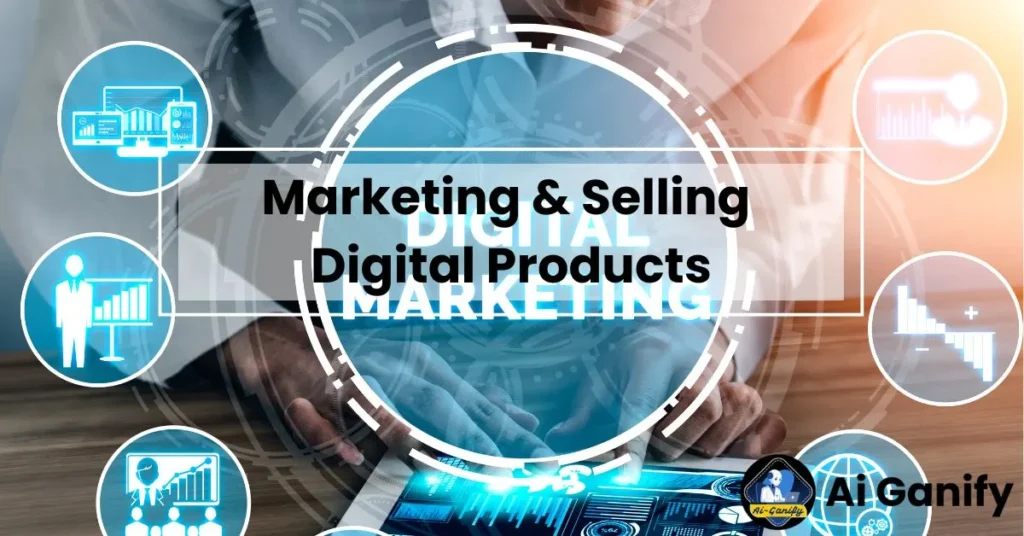
Creating a great digital product is only half the battle.
If no one sees it, it won’t sell—no matter how amazing it is.
So, how do you get your product in front of the right people and turn them into paying customers?
Let’s dive into the best marketing strategies to boost visibility and drive consistent sales.
How to Use SEO, Social Media & Paid Ads to Drive Traffic
To sell more, you need traffic—and the best way to get it is through SEO, social media, and ads.
🔍 SEO – Get Free Traffic from Google & Marketplaces
SEO (Search Engine Optimization) helps people find your product organically on Google, Etsy, Gumroad, or any marketplace.
✔ Find the right keywords. Use free tools like Ubersuggest or Google Keyword Planner to see what people are searching for.
✔ Optimize product titles & descriptions. Include keywords naturally.
✔ Get backlinks. Write guest posts or collaborate with bloggers to link back to your product.
📌 Example: An Etsy seller ranks #1 for “digital planners” by using the right keywords in their title and tags.
📲 Social Media – Build an Audience That Buys
Social media is a goldmine for selling digital products, but posting randomly won’t work.
✔ Instagram & Pinterest – Best for visual products (templates, printables, eBooks).
✔ TikTok & YouTube – Great for tutorials and showing how your product helps.
✔ Facebook Groups – Join and engage in niche communities related to your product.
📌 Example: A Canva template seller gains 30,000 Pinterest views per month, leading to consistent Etsy sales.
💰 Paid Ads – Get Fast Sales with Targeted Traffic
If you want instant visibility, paid ads can skyrocket your sales.
✔ Facebook & Instagram Ads – Best for promoting templates, courses, or printables.
✔ Google Ads – Works well for people actively searching for your product.
✔ Pinterest Ads – Ideal for printables and design-based products.
📌 Example: A seller spends $50 on Facebook ads and makes $500 in sales by targeting people looking for digital planners.
Advanced Content Marketing Techniques
If you want consistent, long-term sales, you need content marketing.
✍️ Blogging – Get Free Google Traffic to Your Product
Blogging is a powerful way to attract buyers without spending money on ads.
✔ Write helpful posts related to your product. Example: Selling planners? Write “How to Stay Productive with a Digital Planner.”
✔ Add your product link naturally. Don’t be salesy—just show how it helps.
✔ Use SEO to rank on Google. Target long-tail keywords that have low competition.
📌 Example: A seller gets 5,000+ monthly visitors to their blog and converts them into buyers.
🎥 YouTube – Show, Don’t Just Tell
People love video content.
If you show how your digital product works, buyers will trust you more.
✔ Create tutorials. Example: “How to Use My Digital Planner in GoodNotes.”
✔ Use keywords in your title & description. Helps rank on YouTube search.
✔ Link to your product in the description.
📌 Example: A creator makes $1,500/month selling digital templates by posting YouTube tutorials.
🎁 Lead Magnets – Get Emails & Sell More Later
Not everyone buys on the first visit.
That’s why email marketing is key.
✔ Offer a freebie – Give a free digital download (mini version of your product).
✔ Collect emails – Use a tool like ConvertKit or MailerLite.
✔ Sell to them later – Send helpful emails and promote your paid products.
📌 Example: A seller gets 500+ email subscribers from a free Canva template and later sells them a premium bundle.
How to Build a Brand (Not Just Sell One-Off Items)
The secret to long-term success?
Don’t just sell random products—build a brand people trust.
🏆 Pick a Niche & Stick to It
Buyers trust specialists, not generalists.
✔ Example: Instead of selling random Canva templates, focus on business templates.
📌 Result: Customers return because they know you’re the expert in that niche.
🚀 Be Everywhere Your Customers Are
A brand isn’t just a store—it’s an experience.
✔ Have a website to showcase your products.
✔ Use Instagram, Pinterest, & YouTube to grow your audience.
✔ Start a blog or email list to keep them engaged.
📌 Example: A digital product seller has a cohesive brand across Instagram, Etsy, and a blog—leading to more trust and sales.
Final Thoughts: Marketing That Actually Works
✔ Use SEO, social media, and ads to get traffic.
✔ Leverage blogging, YouTube, and lead magnets for long-term sales.
✔ Build a brand, not just a store, to create repeat customers.
Customer Support, Legal Considerations & Scaling

Creating a great digital product is just the beginning.
Once you start selling, you’ll face refund requests, piracy issues, and tax obligations.
You’ll also have opportunities to improve products based on feedback and scale to earn passive income.
Let’s break it all down step by step.
Handling Refunds, Piracy Protection & Tax Compliance
Dealing with refunds, piracy, and taxes might not sound fun, but getting these right can save you headaches and legal trouble.
💰 Handling Refunds the Right Way
Digital products are usually non-refundable, but some buyers will still request refunds.
✔ Have a clear refund policy – State whether refunds are allowed and under what conditions.
✔ Offer store credit instead of refunds – This keeps customers engaged with your brand.
✔ Provide great customer support – Sometimes, people request refunds because they don’t know how to use your product. Offer helpful guides or video tutorials instead.
📌 Example: An Etsy seller reduces refund requests by adding a FAQ section explaining how to use digital planners in GoodNotes.
🔒 Protecting Your Digital Products from Piracy
Piracy is a real issue for digital products. Some people will buy your product once and resell or share it for free.
✔ Use license agreements – Clearly state that reselling, sharing, or modifying your product is not allowed.
✔ Add watermarks to previews – Prevents people from downloading and using them without purchasing.
✔ Search for pirated copies – Use tools like Google Alerts or DMCA takedown requests to remove stolen content.
📌 Example: A designer finds her Canva templates being resold illegally and successfully gets them taken down using a DMCA complaint.
📊 Tax Compliance for Digital Product Sellers
Taxes depend on where you sell and where your customers are located.
✔ Sales tax – Some platforms (like Gumroad) collect taxes automatically. Others (like Shopify) may require manual setup.
✔ Income tax – Keep track of your earnings and expenses to file correctly.
✔ Check VAT & global tax rules – If selling internationally, check whether you need to collect VAT or GST (especially in the EU & UK).
📌 Example: A Shopify seller realizes they must collect VAT in Europe, so they use a plugin to automate tax calculations.
Leveraging Customer Feedback to Improve & Expand
Your customers are your biggest source of business growth.
Listening to their feedback helps you improve your product, create new offers, and build trust.
📢 Collecting Customer Feedback the Right Way
✔ Surveys & Polls – Use Google Forms or Typeform to ask what customers love & what they struggle with.
✔ Read Reviews & Comments – Etsy, Gumroad, and Sellfy all allow customers to leave reviews.
✔ Check Support Emails & FAQs – If people keep asking the same question, you might need to improve your product or instructions.
📌 Example: A Canva template seller noticed multiple reviews saying “I wish there were more color options.” She added a new color bundle—and sales doubled.
🚀 Expanding Your Product Line Based on Demand
Once you know what customers want, create related products to increase sales.
✔ Offer upgrades & add-ons – If you sell planners, add matching sticker sets.
✔ Create product bundles – Package multiple related products at a discounted price.
✔ Launch new versions – Keep your products fresh with yearly updates.
📌 Example: A seller started with one digital notebook. After listening to customer feedback, they expanded into a full productivity bundle—tripling their revenue.
Scaling Through Automation, Affiliates & Partnerships
Want to make passive income and scale your digital business?
The secret is automation, affiliates, and partnerships.
🤖 Automate to Save Time & Increase Sales
✔ Set up email funnels – Use ConvertKit or MailerLite to automatically send emails when someone signs up.
✔ Use social media scheduling – Plan posts ahead using tools like Later or Buffer.
✔ Sell on multiple platforms – List your products on Etsy, Gumroad, and Shopify to reach more buyers.
📌 Example: A digital course creator uses an email funnel to send automated “discount reminders.” This increases conversions by 30%.
👥 Affiliate Programs – Let Others Sell for You
Affiliates promote your product and earn a commission when they make a sale.
✔ Platforms like Gumroad, ThriveCart & Payhip allow easy affiliate setup.
✔ Reach out to bloggers, YouTubers & influencers in your niche.
✔ Offer 20-30% commission to attract high-quality affiliates.
📌 Example: A Notion template creator gets YouTubers to review his product. He pays 30% commission per sale, and his revenue doubles in one month.
🤝 Partnerships – Expand Your Reach with Collaboration
Teaming up with other creators can help you reach new audiences.
✔ Partner with complementary brands – Example: If you sell eBooks, collaborate with a course creator in the same niche.
✔ Do joint promotions – Cross-promote each other’s email lists or social media audiences.
✔ Host a giveaway or bundle sale – Attract new buyers by offering a limited-time bundle deal.
📌 Example: A printable seller partners with a popular Instagram influencer to offer an exclusive discount code. Sales skyrocket in 48 hours.
Final Thoughts: Build, Protect & Scale Your Business
✔ Protect your business – Have a refund policy, piracy protection, and tax compliance in place.
✔ Listen to your customers – Use feedback to improve and expand your product line.
✔ Automate & scale – Use email marketing, affiliates, and partnerships to increase sales passively.
👉 Also Read: How to Make Money From Freelancing With No Skills
Conclusion: Your Digital Product Journey Starts Now!
If you’ve made it this far, congratulations! 🎉
You now have a solid roadmap to creating, marketing, and scaling your digital products.
But here’s the real secret—you don’t have to do everything at once.
Start small, learn as you go, and take action today.
Recap of Key Takeaways
Before you go, let’s quickly recap what you’ve learned:
✔ Choosing the Right Digital Product – Sell something that people actually want.
✔ Creating High-Quality Products – Use Canva, Notion, or AI tools to make professional designs.
✔ Pricing & Monetization – Use psychological pricing, bundles, and subscriptions to increase sales.
✔ Marketing & Selling – Leverage SEO, social media, and content marketing to drive traffic.
✔ Scaling & Automation – Use email funnels, affiliates, and partnerships to earn passively.
Each step builds on the previous one, leading to long-term success.
Start Small, Then Scale Up 🚀
You don’t need a perfect plan to begin.
Start with one product. Improve it based on feedback. Then expand.
✔ Step 1: Pick a simple idea – Example: A printable planner instead of a full course.
✔ Step 2: Launch on one platform – Start with Etsy, Gumroad, or Shopify before expanding.
✔ Step 3: Improve & scale – Add bundles, upsells, and automation to grow.
📌 Example: A seller started with one Notion template. After two months, she added a bundle—and doubled her income.
Ready to Take Action? Here’s Your Next Step!
💡 Want to make the process easier? Grab this FREE Digital Product Launch Checklist! 🎯
This checklist will help you:
✅ Choose the right product
✅ Set up your pricing & marketing
✅ Avoid common mistakes
